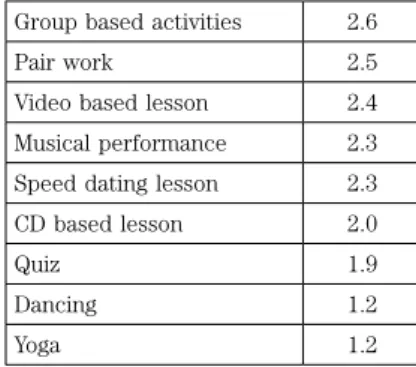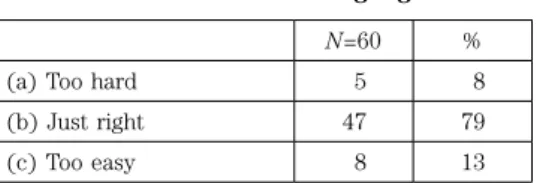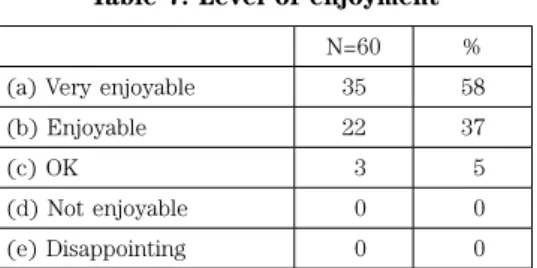Intensive Program
David Svoboda
BACKGROUND
The English Intensive Program complements the English Communication Program estab- lished in 1993 under the auspices of the Institute of Foreign Language Education and Research at Kansai University.
Three intensives are held a year, in August, September, and February with four days spent at the Senri-yama Campus and an overnight stay at Kansai University’s Asuka Seminar House.
Each course is taught by five different teachers from the Communication Program.
The intensives are open to all students at the university. However, the great majority who attend are enrolled in the Communication Program. The participants are not English majors, but are required to take English as a compulsory subject during their first year at university. Student English ability ranges from false beginner to intermediate level. The total number of students for each intensive is 60 and students are randomly placed in 5 classes. This class constitutes their ‘homeroom’ in which approximately 50% of all learning activities at the inten- sive take place.
Students attending an intensive are exposed to 30 hours of formal instruction and are able to interact socially with teachers at the Asuka Seminar House at various times outside formal instruction times.
OVERVIEW
As part of ongoing teacher development the Intensives Professional Development Group (IPDG) was established in 2007 among the 12 Special Foreign Language Lecturers within the Institute of Foreign Language and Education. The aims of the IPDG formulated in 2007 were: 1. to obtain a better understanding of student motivations for attending an intensive;
2. to identify activities that students view favorably and unfavorably; 3. to identify potential areas for improvement in the program;
4. to evaluate overall student satisfaction with the program as it is currently formatted; and 5. to assist new teachers with information and preparation of intensive courses.
The IPDG concluded that a survey of intensive students was required to obtain data to enable the abovementioned aims to be met and the questions were designed so that the results might assist in meeting these aims. Prior to this survey student feedback in relation to intensives was elicited by participating teachers in a random ad hoc manner in conversation. The aims of the evaluation were to collect data that would assist teachers in the Communication Program in deciding whether the intensive needed to be modified in any way to improve them, and to gather information that might be used to remedy shortcomings.
The survey questions were developed and revised in the weekly IPDG meetings over the course of the autumn semester, 2007.
SURVEY METHOD
A seven-question survey titled ‘Kansai University English Intensive Survey’ was adminis- tered to 60 students at the completion of the February, 2008 intensive (see Appendix). For each question on the questionnaire, students were given the opportunity to write comments. For the most part, the students were in their first or second year, and had a variety of majors and approximately 60% of the students were female and 40% male.
RESULTS AND DISCUSSION
Question 1. Student motivation for attendance
Select the main reason why you attended this intensive. Please circle only one.
Table 1. Motivation for attending intensive
N=60 % (a) To improve my conversation skills 28 47 (b) To communicate with native speakers 18 30
(c) To make friends 8 13
(d) To improve my TOEIC score 6 10
It is clear from this study that the great majority students were motivated to attend the intensives to improve their communication skills and to have the chance to communicate with the teachers outside the formal constraints of English classes at university.
The intensive advertising had previously targeted improving student’s TOEIC score. However, it is clear that the great majority of students are not motivated to attend for this purpose.
There are three implications for teachers from these results. Firstly, the intensives should focus on activities that promote conversation skills. Next, opportunities for significant interac- tion between teachers and students should be an important component of the intensives.
The third implication relates to the current method of advertising the intensives. Current information sheets and posters emphasize that the intensive can improve student TOEIC scores. Less emphasis on TOEIC and more on conversation skills and teacher-student interac- tion would be more appropriate.
Question 2. Likeability of activities
Which of the following activities did you like or dislike? Please circle from 1-3 (3-liked, 2-okay, 1-didn’t like). Please comment on activities.
Table 2. The descending mean scores for likeability of activities
Group based activities 2.8 Musical performance 2.6
Pair work 2.5
Speed dating lesson 2.2 Video based lesson 1.9
CD based lesson 1.8
Quiz 1.7
Dancing 1.6
Yoga 1.5
Group based activities, musical performance, and pair work with mean scores of 2.8, 2.6, and 2.5 respectively were the most liked activities. The results indicate a general trend that the more communicative the activities are, the more popular they are. The bottom rated activi- ties, the dancing lesson and yoga, rated poorly because it would seem students found them to have limited communicative value. The overall attitude of the great majority of students can be summarized in this written comment by a student: I didn’t like it because I wanted to communicate with friends.
These two activities conducted at the Asuka component of the intensive were aimed at increasing the ‘fun factor’. However, it is clear from the results that the great majority of students want communicative value in all the activities they undertake.
The Quiz activity, in which students are required to prepare questions in their ‘homeroom’ and submit them for a plenary quiz competition, has been a standard activity in the intensive format for a number of years. However, it ranked poorly. A comment which best summarizes the majority of student’s attitudes to the quiz was: We thought and spoke in Japanese in the preparation.
It is clear from these results that students like activities that they perceive to be high in communicative value.
Question 3. Usefulness of activities
Which of the following activities did you find useful for improving your English?
Please circle from 1-3 (3-useful, 2-somewhat useful, 1-not useful). Please comment on activities.
Table 3. The descending mean scores for usefulness of activities.
Group based activities 2.6
Pair work 2.5
Video based lesson 2.4 Musical performance 2.3 Speed dating lesson 2.3
CD based lesson 2.0
Quiz 1.9
Dancing 1.2
Yoga 1.2
There seems to be almost direct correlation between likeability level of an activity and its
Question 4. Format
What did you think of the rotation system at Senri-yama? Please circle.
Table 4. Attitudes to the rotation system.
N=60 %
(a) Liked the system 42 70
(b) It was okay 18 30
(c) Didn’t like it 0 0
The current format of the intensive has evolved over the year to a point where a standard schedule is used by all three intensives over the course of the academic year. The main concern of the IPDG in relation to format was rotation which is scheduled each morning in the first four days of the intensive at Senri-yama. ‘Homerooms’ rotate between the teachers for approximately 40 minutes each with each teacher teaching their individually prepared lesson. The justification for the rotation system is that it gives all students the chance to interact with different teachers of different nationalities. However, a number of members of the IPDG expressed concerned that this system places undue stress on the students who must adapt to different teaching styles in short period of time and that the physical requirement of constantly changing classroom over four mornings might be tiring.
Students were asked to indicate if they like the rotation system. The results were that 42 students indicated they did, 18 indicated it was OK, and no students indicated they didn’t like it. Clearly, students like the opportunity to be able to interact with all five teachers and student comments reflected this.
Question 5. Level of language
What did you think of the English level at the intensive? Please circle.
Table 5. Level of language.
N=60 %
(a) Too hard 5 8
(b) Just right 47 79
(c) Too easy 8 13
Teachers of the intensives are conscious of the fact that the intensives are attended by the more highly motivated students of the Communication Program and that a number of
Accordingly, in preparing the activities teachers aim for a level of English slightly higher than that taught in the Communication Program. The results indicate that the current targeted level of English is appropriate.
Question 6. Student satisfaction
Did the intensive meet your expectations? Please circle.
Table 6. Level of satisfaction
N=60 %
Yes 28 47
Almost 27 45
No 5 8
The results indicate approximately half of the students felt their expectations were met. Students expressed their satisfaction with the intensive in the following comments: I expected to talk a lot and could do that and I could make friends deeply and have more chance to speak with teachers.
A number of students for whom the intensive didn’t meet expectations commented that they expected the intensive to be more serious: I thought we would study harder and wanted to do that. The implication for future teachers of intensives is that they need to explain, in both oral and written form, more clearly and in more detail exactly what the focus of the intensive is prior to the enrolment period. Clearer and more detailed information from teachers may help avoid false expectations in the future.
Question 7. Student enjoyment
How would you rate your experience at the intensive? Please circle.
Table 7. Level of enjoyment
N=60 %
(a) Very enjoyable 35 58
(b) Enjoyable 22 37
(c) OK 3 5
(d) Not enjoyable 0 0
(e) Disappointing 0 0
The results for enjoyment were very positive and seem to reflect the focus teachers place on ensuring individual activities and the overall tenor of the intensives is an enjoyable learning experience.
CONCLUSIONS AND RECOMMENDATIONS
1. The current focus of the intensives on improving conversation skills is valid, as this is the prime motivation for the majority of students who attend.
2. A large percentage of students are motivated to attend as they wish to be able to communi- cate with the teachers. As such, teacher-student interaction time could be increased in future intensives.
3. Only a small percentage of students are motivated to attend to improve their TOEIC score. Future advertising practices should reflect this with less emphasis on TOEIC.
4. The results of this survey indicate that students favor activities that are communicative in nature with a high degree of student-student and teacher-student interaction. Future inten- sives should focus on activities that satisfy these desires of students.
5. The current rotation system of classes at Senri-yama is liked by students and should be maintained.
6. The survey revealed the current level of instructional language is appropriate.
7. The levels of student satisfaction and enjoyment were high. Some students commented they expected to study harder. In the future teachers can remedy this expectation by insuring potential intensive students are aware that the focus is on communicative learning in a fun environment. This would mitigate the chances of dissatisfaction with the intensives based on the belief that the intensive would be ‘hard’ study.
Appendix. Intensive Survey
KANSAI UNIVERSITY ENGLISH INTENSIVE SURVEY
1. Select the main reason you attended the intensive? Please circle one. (a) To improve my TOEIC score
(b) To improve my communication skills (c) To communicate with native speakers (d) To make friends
Comments
2. Which of the following activities did you like or dislike? Please circle from 1-3 (3-liked, 2-okay, 1-didn’t like). Please comment on activities.
a. Group based activities b. Pair work c. Yoga d. Quiz
3 2 1 3 2 1 3 2 1 3 2 1
e. Musical performance f. Speed dating g. Video lesson h. Dancing
3 2 1 3 2 1 3 2 1 3 2 1
i. CD lesson 3 2 1 Comments
3. Which of the following activites did you find useful for improving your English? Please circle from 1-3 (3-useful, 2-some what useful, 1-not useful)
a. Group based activities b. Pair work c. Yoga d. Quiz
3 2 1 3 2 1 3 2 1 3 2 1
e. Musical performance f. Speed dating g. Video lesson h. Dancing
3 2 1 3 2 1 3 2 1 3 2 1
i. CD lesson 3 2 1 Comments
4. What did you think of the rotation system at Senri-yama? Please circle. (a) Liked the system (b) it was okay (c) didn’t like the system
5. What did you think of the English level at the intensive? Please circle. (a) Too hard (b) Just right (c) Too easy
Comments
6. Did the intensives meet your expectations? Please circle. (a) yes (b) almost (c) no
Comments
7. How would you rate your experience at the intensive? Please circle. (a) very enjoyable (b) enjoyable (c) OK
(d) not enjoyable (e) disappointing Comments



